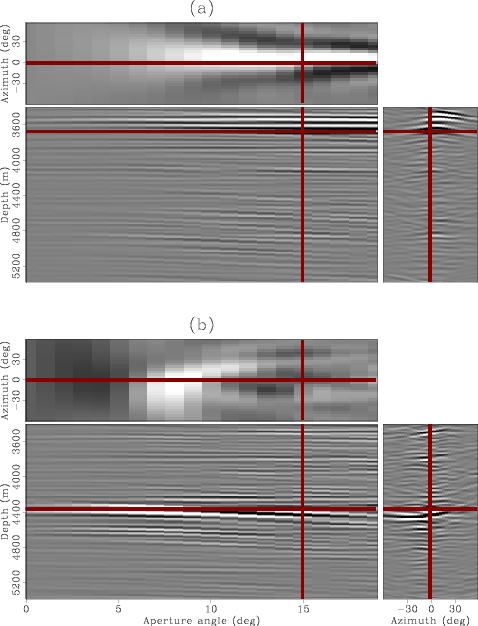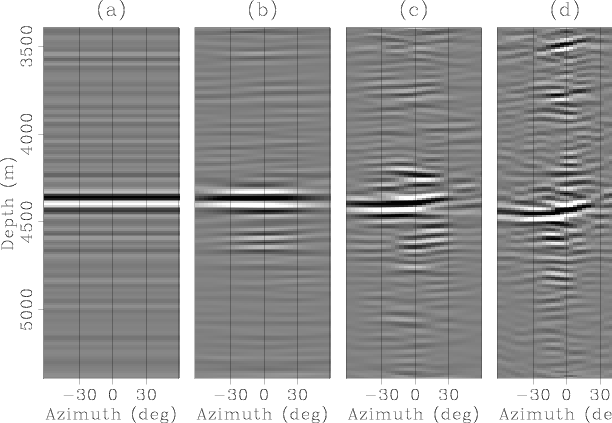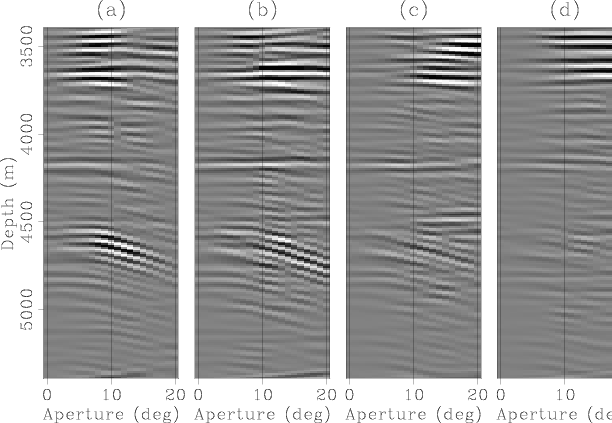|
|
|
|

|
|---|
|
3d-gaths-14000-13500-11000-13000
Figure 15. 3D angle gathers. (a) at CMPX=14000 m and CMPY=13500 m. (b) at CMPX=11000 m and CMPY=13000 m. Notice the strong primaries above 5500 m depth in panel (a) and the strong multiple below 6000 m depth in panel (b). |
|
|
In order to investigate the variation of the residual moveout of primaries and multiples with reflection azimuth, I plot in Figure 16 the angle gather at location CMPX=13000 m and CMPY=13000 m for aperture angles of 0, 5, 10, 15 and 20 degrees. At zero aperture angle (panel (a)), neither the primaries nor the multiples show any azimuth resolution. As the aperture angle increases, the primaries are focused to a relatively narrow range of azimuths (panel (e) above 5500 m) whereas the multiples are essentially scattered. Similarly, Figure 17 shows the same gathers but at location CMPX=14000 m and CMPY=14000 m. Again, notice the azimuth focusing of the weak primaries at the top (panel (e)) and the upswings of the multiple (panels (c), (d) and (e)). The lack of azimuth focusing of the multiples with increasing aperture angle is a consequence of the crossline dip and velocity lateral velocity variations that cause the multiple path to be very complex with no defined azimuth even for large aperture angle.

|
|---|
|
3d-az-13000-13000
Figure 16. 3D angle gathers as a function of azimuth for aperture angles of 0, 5, 10, 15 and 20 degrees (panels (a) through (e)). The gather is taken at CMPX=13000 m and CMPY=13000 m. |
|
|

|
|---|
|
3d-az-11000-13000
Figure 17. 3D angle gathers as a function of azimuth for aperture angles of 0, 5, 10, 15 and 20 degrees (panels (a) through (e)). The gather is taken at CMPX=11000 m and CMPY=13000 m. |
|
|
Finally, to investigate the variation of the residual moveout of the primaries and the multiples
with aperture angle, Figures 18 and 17 show
angle gathers at reflection azimuths of -40, -20, 0, 20, 40 at the same locations as
Figures 16 and 19, respectively. Notice that
in both figures the moveout of the primaries is flat at all the azimuths that illuminate the
reflector whereas the multiple shows the expected over-migrated moveout. It is interesting to
see that the multiple essentially disappears in panel (e) of Figure 18
indicating that it was not illuminated at that azimuth (at least not in the aperture range of 0
to 20 degrees). This is somewhat in contrast to the results for the synthetic data in
Chapter ![]() that indicated that the multiple was illuminated with an
azimuth range similar to that of the primary (compare the depth slices in panels (a) and (b)
of Figure
that indicated that the multiple was illuminated with an
azimuth range similar to that of the primary (compare the depth slices in panels (a) and (b)
of Figure ![]() . This is not the case with this real data (compare the
depth slices in panels (a) and (b) of Figure 15) for
which the multiples seem to be illuminated preferentially at small aperture angles. A similar
behavior is well known with 2D data.
. This is not the case with this real data (compare the
depth slices in panels (a) and (b) of Figure 15) for
which the multiples seem to be illuminated preferentially at small aperture angles. A similar
behavior is well known with 2D data.

|
|---|
|
3d-ap-13000-13000
Figure 18. 3D angle gathers as a function of aperture angle for reflection azimuths of -40, -20, 0, 20 and 40 degrees (panels (a) through (e)). The gather is taken at CMPX=13000 m and CMPY=13000 m. |
|
|

|
|---|
|
3d-ap-11000-13000
Figure 19. 3D angle gathers as a function of aperture angle for reflection azimuths of -40, -20, 0, 20 and 40 degrees (panels (a) through (e)). The gather is taken at CMPX=11000 m and CMPY=13000 m. |
|
|
|
|
|
|